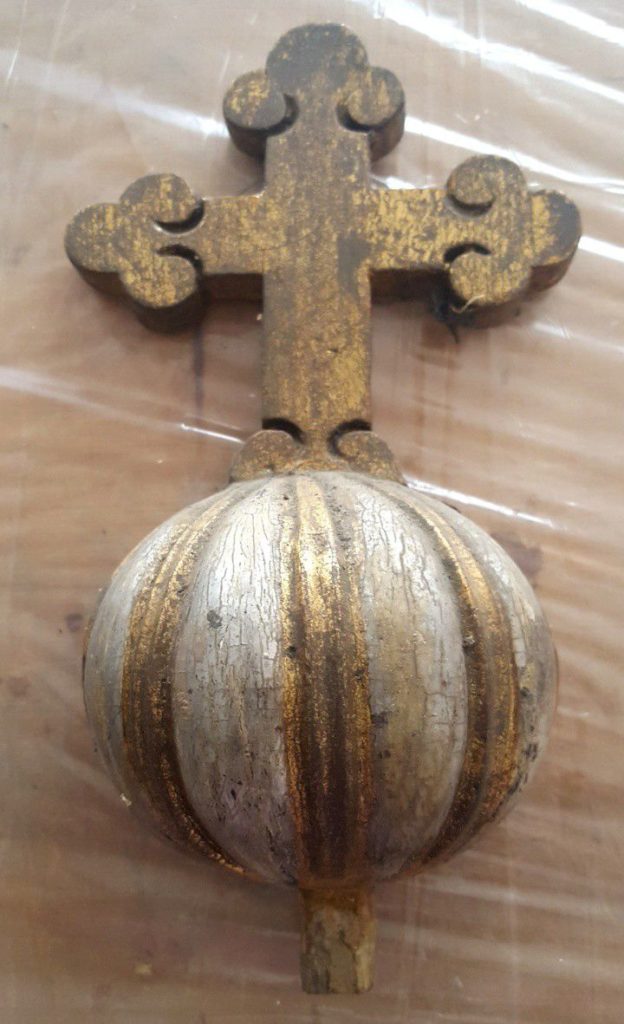Project effects
Church of St. Nicholas – Łubowo
RENOVATION OF THE PULPIT IN THE CHURCH OF ST. NICHOLAS IN ŁUBOWO
The wooden pulpit in the church of St. Nicholas in Łubowo consists of a basket, a backboard and a canopy. The architectural construction has remained untouched since it was placed in the church’s foundations in the 18th century, and it was made of pine wood planks.
The technical condition of the pulpit at the moment of conservation and renovation works was not a reason to concern, taking into account both its construction stability, and damage caused by xylophages. The object is located in a place with a sufficient air circulation, so extensive humidity does not pose threat to it. However, the exterior decoration of the pulpit presents itself differently, both in painting as well as silver and gold metallization. The pulpit lost its gloss almost completely. Paint colour is incorrect, it is too solid. Gilding and silvering in aesthetic perception have a very matt finish.
No signs of original doors which close the entry to the vestry were discovered, and the current fittings mounted on the door are contemporary.



AIM OF RENOVATION
The purpose of the ongoing conservation and renovation works is to restore original technical and aesthetic values. Conservation activities which involved complementation of wooden fragments of pulpit which had been mechanically damaged and deep impregnation in order to preserve the historical substance for the longest period possible. Restoration which included the removal of layers of unoriginal overpaint within the marbleisation part, as well as restoration of gilding and silvering in the original technology of burnished armenian bole clay, is aimed at achieving the original aesthetic values.




COURSE OF RENOVATION
The first stage of renovation works is photographic documentation, and next dismantling of movable elements is carried out. Random sample testing was performed by uncoverings in all parts of the pulpit. Testing revealed many layers of overpaint in different colours – very dark brown, white and blue. Under the layers made in oil and mix water-oil techniques in grey green with a dash of ochre in tempera technique mixed with oil. The layer of paint was relatively thick with visible signs of brush in some places.


Next, deposits of felted dust and all types of screws such as drawing pins, nails and strings were removed. The removal of unoriginal layers of paint followed. On the pulpit’s basket, the original paints were successfully restored on a surface big enough (although dispersed into fragments) to expose it again. The planks of the construction were in a good technical condition, which gave structural support. Unoriginal layers of metal in silver and gold colours were removed from sculptural elements, as well as most of thick and cracked glue and chalk primer which had come off in big chunks. Wood of the carvings preserved in good condition. No signs of xylophages’ foraging were discovered. Numerous cracks in the places where planks are joined appear.


There was a small open space in the arch of the doors’ jamb which lead from the vestry to the pulpit, with visible tips of an arch-shaped frame and wide cracks between beams. Primered wooden blocks formed into an arch were used.
The original paint obtained after the removal of overpaint was integrated into the decor of the marbleised polychromy of the pulpit’s basket and backboard. The complete filling of paint losses was made with acrylic paints. Gilded and silvered elements carved in the technique of traditional gilding were primered with adhesive-chalk primer. In the basket and the backboard where original paint losses occurred, also levelling adhesive-chalk primer was used in order to acquire hight even with the original layer.
Gilded and silvered elements of the pulpit were metalized in a traditional gilding technique with adhesive-chalk primer, on the black bole – silver leaf, on the red – 23 karat gold leaf.



